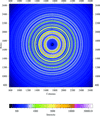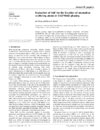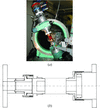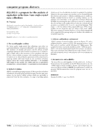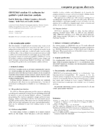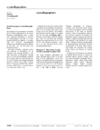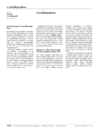issue contents
December 2003 issue

Cover illustration: Protein crystals in a 2 µl gelled microbatch drop dispensed automatically under oil. Courtesy of A. Moreno, E. Saridakis & N. E. Chayen [J. Appl. Cryst. (2002), 35, 140-142].
research papers
A new method to perform neutron reflectometry measurements is discussed, based on Larmor precession of polarized neutrons in the spin-echo mode.
An analytical approach to the resolution problem for inelastic neutron spectroscopy using three-axis spectrometers with spin-echo is discussed. Using a Gaussian approximation of the transmission function of the three-axis spectrometer and a second-order expansion of the total Larmor phase, the instrumental resolution function of an idealized spin-echo instrument is obtained, and is extended to include the effects of sample properties, discussed in detail.
A method that improves the accuracy of misorientations determined from TEM Kikuchi diffraction patterns is devised. The method requires at least two foil inclinations.
Three-beam diffraction is utilized to obtain quantitative estimates of parameters within the Darwin mosaic model.
Download citation


Download citation


The thermal expansion tensor and the temperature variation of the principal structure parameters of two biguanidinium dinitramides have been determined at several temperatures in the range 85–298 K from single-crystal X-ray diffraction data. Rigid-body analysis of the molecular thermal motion in the same range was performed using the libration and translation tensors.
High-quality medium-resolution (Qmax ≤ 28.5 Å−1) atomic pair distribution functions (PDF) have been obtained from crystalline materials using an image-plate detector. Good counting statistics and fast data collection make this technique very promising for studying the structures of nanocrystalline and disordered materials.
The X-ray multiple-diffraction technique was applied to obtain the piezoelectric coefficients (d21, d22, d23, d25) of L-arginine hydrochloride monohydrate.
It is shown that the interfacial profile between two bonded wafers can be directly determined using X-ray reflectivity without resorting to standard model-fitting of the data.
The real-space small-angle scattering structure functions and the isotropic scattering intensity of the isolated single cells of the tessellation of a `dead leaves' model (produced by spherical primary grains of constant diameter) have been investigated. The cells possess a random shape like the pieces of a puzzle.
Download citation


Download citation


The distribution of iron and nickel in a mixed iron/nickel phosphate with a derivative olivine structure has been determined using Rietveld analysis of powder neutron diffraction data from isotopically nickel-substituted materials. A critical comparison of the results with anomalous scattering experiments is presented, showing that the isotopic substitution technique is superior for resolving nickel and iron occupancies on shared sites from powder data, with a detection limit approaching 0.1%.
A new method to obtain three-dimensional information on atomic arrangement from a monochromatic Laue pattern based on the Helmholz–Kirchhoff integral theorem is presented and experimentally proved by applying the algorithm to the thermal diffuse scattering from a single crystal.
A simple glass-based plate for screening the crystallization of membrane proteins in lipidic mesophases and of soluble proteins by the batch method is described. Trials with <20 ng membrane protein have been performed successfully.
The options are discussed in analysing diffraction patterns of multibilayers exhibiting only weak Bragg peak scattering with full-q-range models. Particular attention is paid to the applicability of the models and the influence of instrumental resolution.
The local structure of CdS–glutathione nanocrystals has been determined from high-energy X-ray diffraction data by means of radial distribution function analysis.
Evaluation of 16 test data sets suggests ways to optimize SnB for large substructures or weak data.
An algorithm based on the Hough transform is devised to detect and measure symmetry in binary images of atomic structures.
The cationic distribution of nanosize polycrystalline mixed rare earth oxides (synthesized by the sol–gel technique) over the two non-equivalent sites 8b and 24d of the space group  is found to be random in the range 0.0 < x ≤ 0.5 and preferential in the range 0.5 < x ≤ 1.0. Replacing Eu by Yb decreases the lattice parameter linearly and introduces slight changes in the atomic coordinates.
is found to be random in the range 0.0 < x ≤ 0.5 and preferential in the range 0.5 < x ≤ 1.0. Replacing Eu by Yb decreases the lattice parameter linearly and introduces slight changes in the atomic coordinates.
The structure of hard-sphere colloidal suspensions is measured at different concentrations using the recently developed spin-echo small-angle neutron scattering (SESANS) technique. It is shown that SESANS measures real-space correlations ranging from the size of a single particle for a dilute suspension to several particle diameters for a concentrated suspension, a glass and a crystalline state.
A new method for the determination of strain profiles in epitaxic thin films using X-ray diffraction
A new and versatile method is proposed for the determination of strain profiles in epitaxic thin films. It is based on the simulation of the X-ray diffraction (XRD) profiles using cubic B-spline functions to model the vertical lattice displacement profile.
A new type of Michelson interferometer for X-rays is described. It is shown that interference fringes can be generated with the `test' interferometer attached to it.
Diffuse neutron scattering data have been recorded for the molecular crystal d-benzil, C14D10O2, using the time-of-flight Laue technique on the SXD and PRISMA instruments at ISIS.
Surface morphology and defect formation of the {100} face of ZnCd(SCN)4 crystals investigated by AFM
Surface morphology and defect formation of the prismatic {100} face of ZCTC crystals were investigated by atomic force microscopy (AFM).
cryocrystallography papers
A 0.1 mm Kapton-film vacuum chamber was constructed to be mounted on the cold head of a closed-cycle helium cryostat. The use of Kapton instead of beryllium results in a low and practically non-structured background, which is thus tolerable on the area-detection frames of modern CCD detectors.
A new technology for mounting macromolecular crystals for cryocrystallography is described. This technology is extremely well suited to measurements on crystals of sizes down to 10 µm produced in high-throughput crystallization efforts, and is fully compatible with existing hardware for high-throughput cryocrystallography.
short communications
The thermal expansion of two isostructural oxides, Cu2O and Ag2O, has been measured from 10 K to their decomposition temperature.
The initiation of a comparative charge density study on a series of estrogen derivatives revealed the need for a standardized local coordinate system for each atom in order to facilitate comparison of the multipole refinements. Such a system is proposed for the core structure of a generic estrogen molecule and starting parameters for the population of the most prominent multipoles are suggested.
computer programs
UMWEG makes possible the calculation and graphical representation of multiple-diffraction patterns and can be applied to X-rays as well as to neutrons.
The integration of the three-dimensional profile of each node of the reciprocal lattice without an a priori modelling of the shape of the reflections is a prerequisite in order to improve the capability of area detectors in diffraction studies. The automation and application of the seed-skewness method are described.
laboratory notes
A novel method for sample mounting to obtain powder diffraction from very small amounts of samples (ranging from micrograms down to a few nanograms), by using a combination of multiwire area detector, three-circle diffractometer, monochromatic Cu Kα radiation and 10 µm nylon loops, has been developed.
A setup for protein crystallization under an electric field is described.
computer program abstracts
Code for electron density map visualization with the help of the CAVE virtual-reality device is developed. The problems and advantages connected with such an advanced method of data visualization are discussed.
This is the second release of the EQUIV program.
CRYSTALS version 12 contains a modern crystallographic user interface, and novel strategies that incorporate chemical knowledge and crystallographic guidance into the crystal structure analysis software.
crystallographers
Free 

Free 



 journal menu
journal menu
















